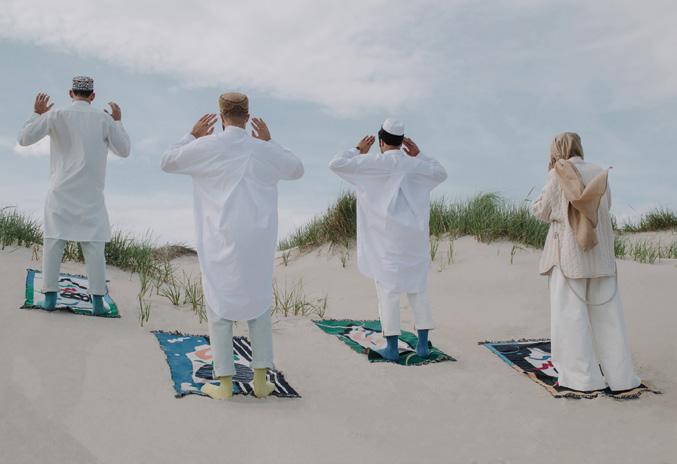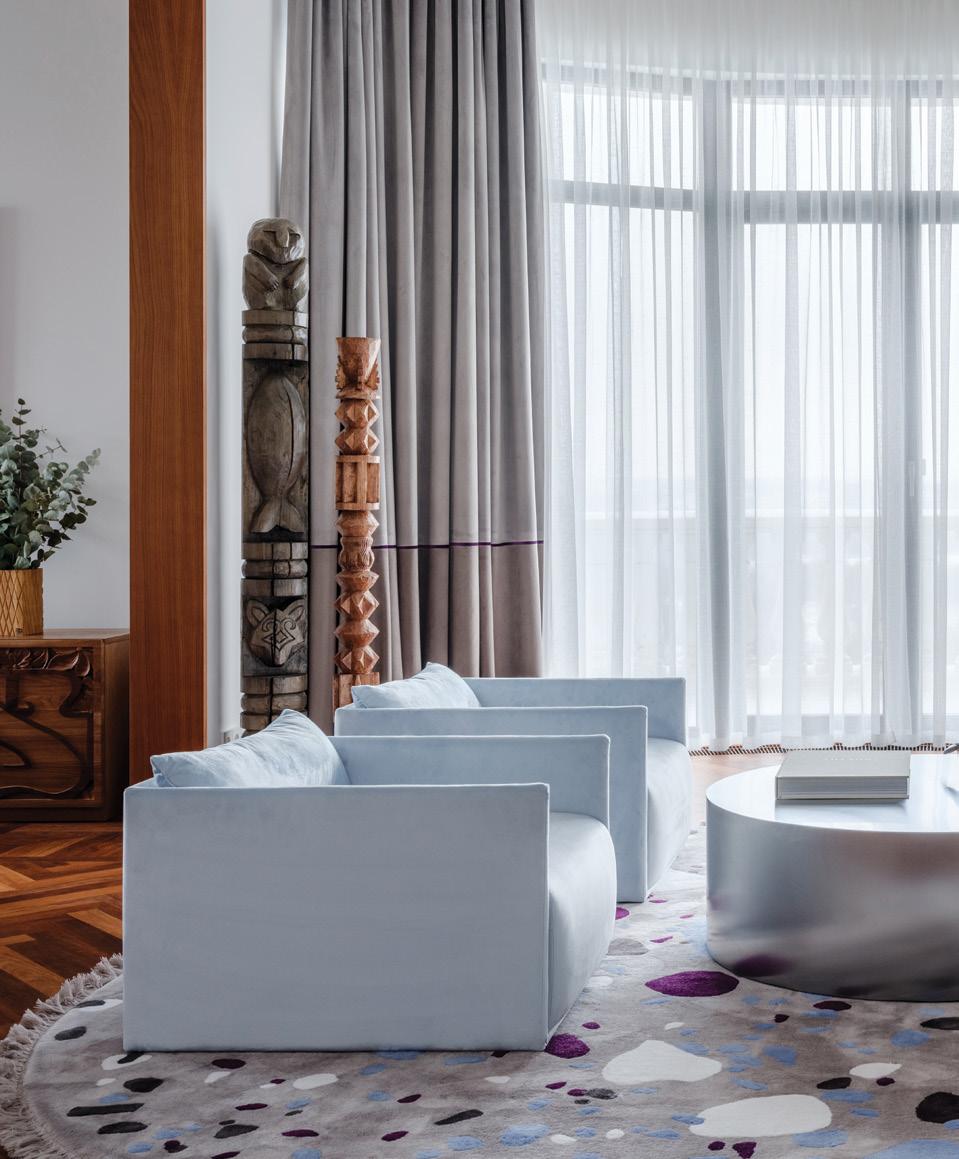
14 minute read
Living with colour
Living
In Moscow, fashion designer Ksenia Chilingarova’s home – created by Harry Nuriev from Crosby Studios – combines historical Russian references with contemporary art
WORDS BY KARINE MONIÉ PHOTOGRAPHY BY MIKHAIL LOSKUTOV COURTESY OF CROSBY STUDIOS
withcolour
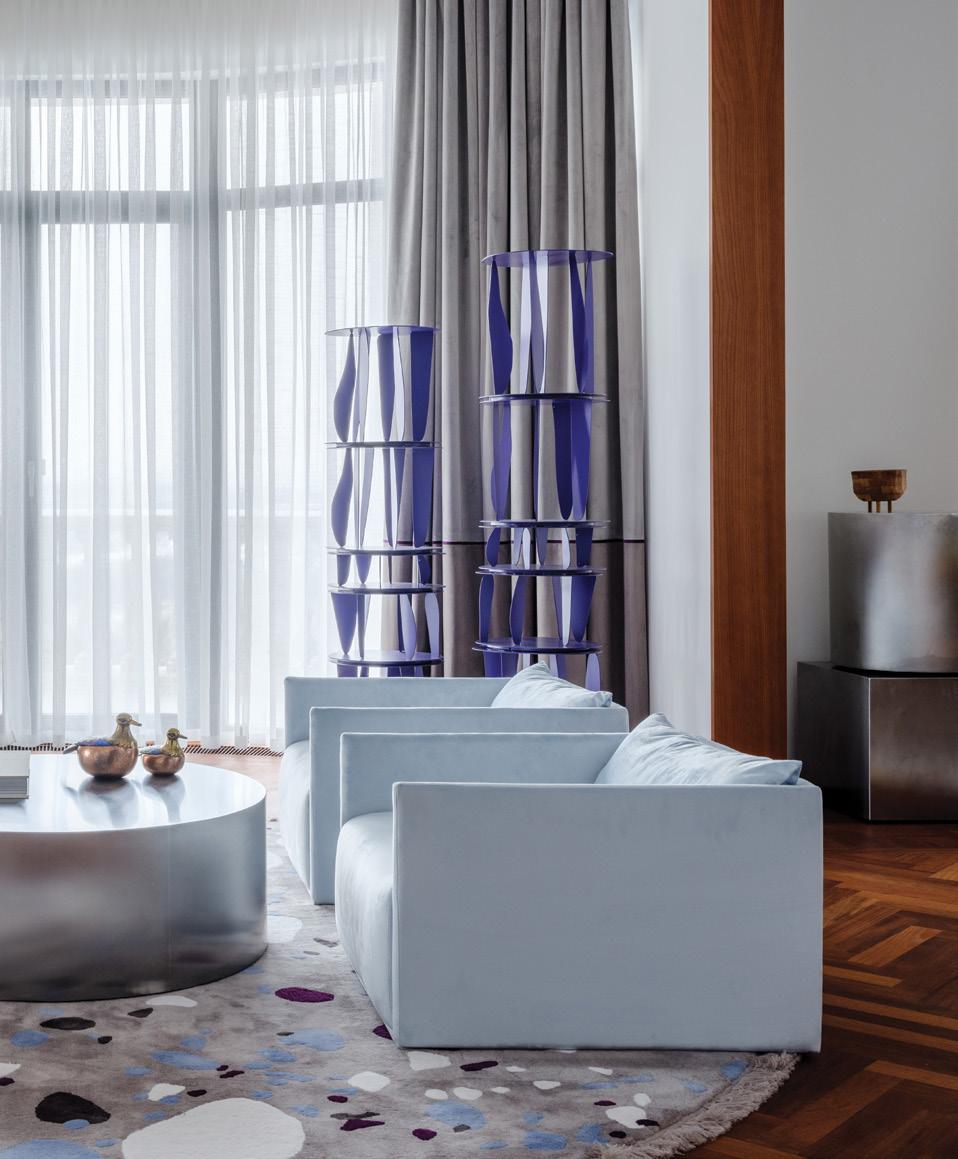
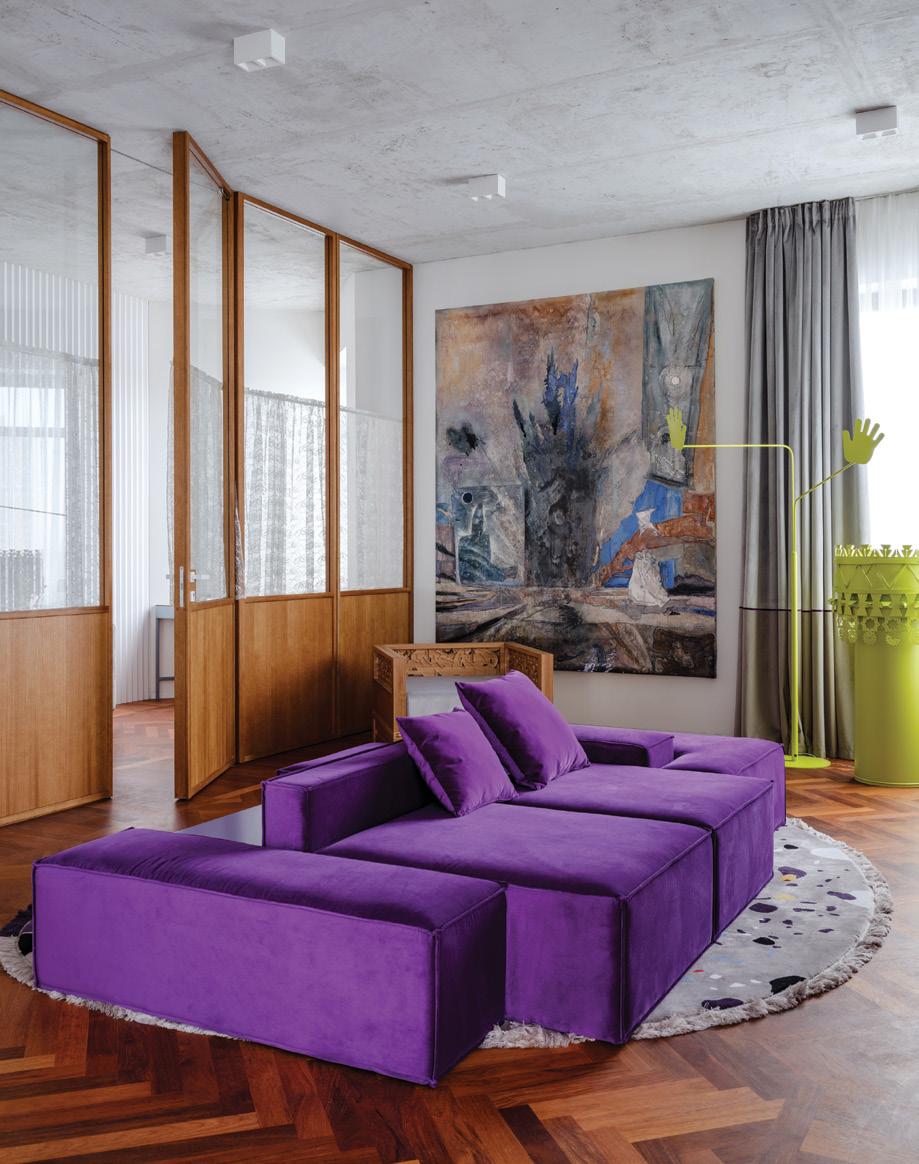
When two creative minds meet and collaborate on a project, the result is inevitably one-of-a-kind. A case in point is the Moscow apartment of fashion designer Ksenia Chilingarova, who trusted Harry Nuriev from Crosby Studios to make the spaces visually daring yet sophisticated. Fashion designer, Ksenia Chilingarova in her Moscow apartment.
“I met Ksenia through a mutual friend, and we had an immediate connection based on similar tastes in art, design, fashion and architecture,” remembers Nuriev. “She was a separate kitchen and a study, the feeling of spaciousness is present in open to my design approach, and I had a feeling that [it was] going to every corner of the apartment. be a great collaboration.” The Russian-born Moscow- and New York- “Most of the walls are white for two reasons,” Nuriev explains. “First, based architect and designer had carte blanche to transform the blank we wanted to add as much light as possible. Second, we needed a suitable apartment into a kaleidoscope of colours and a true reflection of the backdrop for the art collection – we didn’t want the walls to steal the owner’s personality and style. attention. But we added many different colours by experimenting with
Located in the Kutuzovsky district – an historical area near the city the custom-made furniture: there are light blue chairs, a purple sofa, centre with beautiful post-war buildings – the 280-square metre home a pink stool, a green sculpture, etc. We [also included] some nostalgic was not an easy find for Chilingarova. “I had been looking for a big wooden details like a Soviet-style hardwood floor and furniture pieces, apartment for a long time, because I realised at some point that I need which give some warmth to the space.” more space for myself,” she explains. “It is difficult to find large spaces Featuring purple powder-coated shelves designed by Crosby Studios with high ceilings and an abundance of natural light in the centre of and a pair of carved-oak totems, the living room clearly epitomises all of Moscow. That’s exactly what I found in my new apartment, which is why these concepts, becoming a feast for the eyes where contrasts between I fell in love with it. I also wanted [to have] lots of walls to hang beautiful colours, textures and styles are used to create balance throughout. artworks on and a large dressing room. All of that came together [here].” Natural fabric for several decorative elements, steel for some objects and With two bedrooms (master and guest), two bathrooms, a living room, an abstract terrazzo pattern for the bath complement the look.
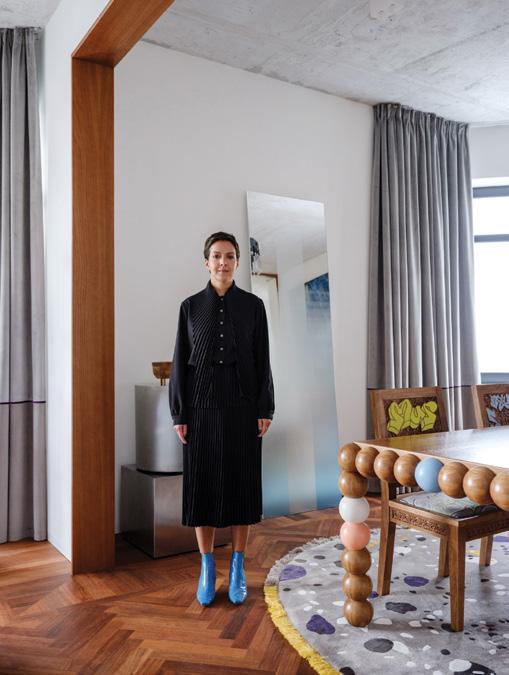
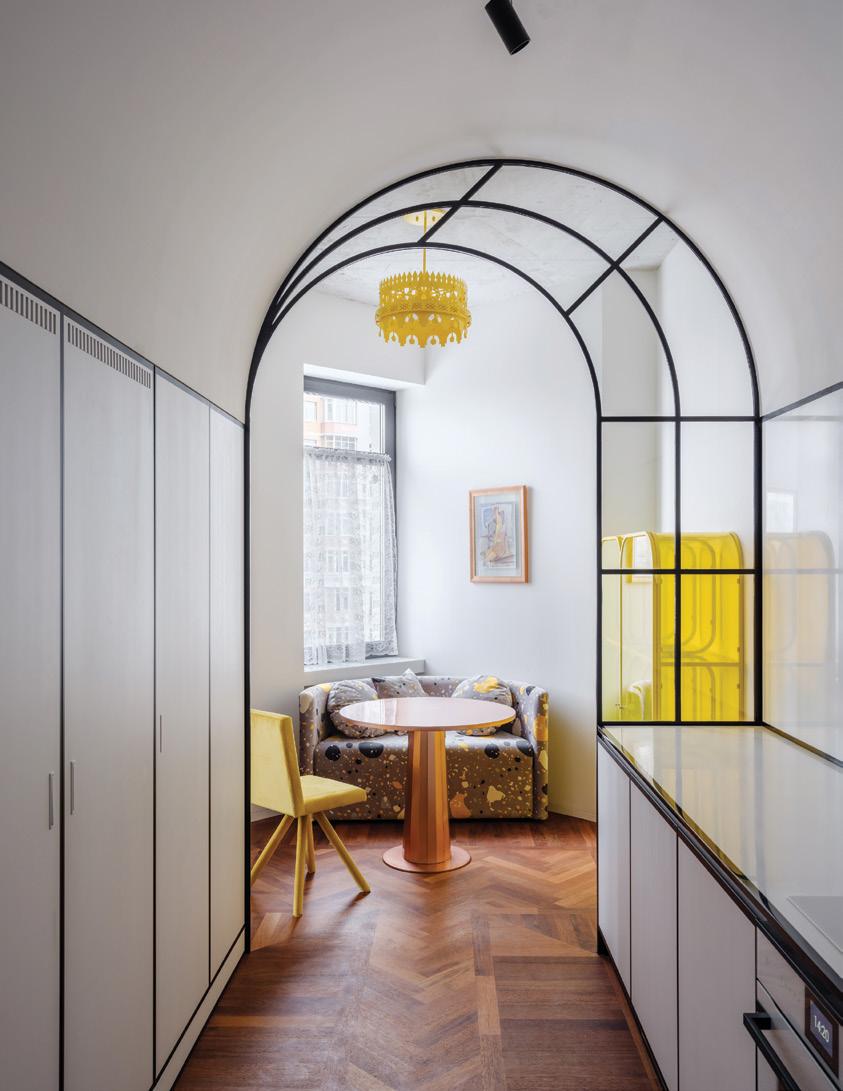
HARRY NURIEV
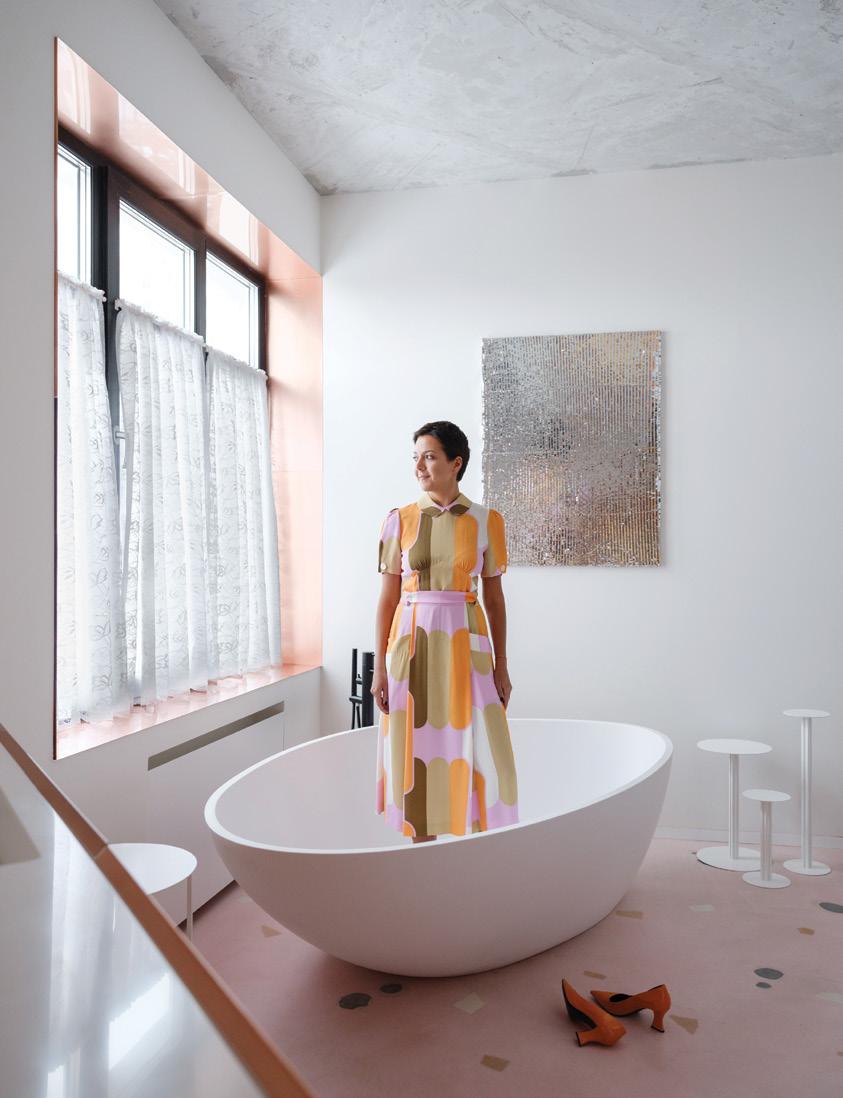
For inspiration, Nuriev started with Chilingarova’s fashion taste. Deep research into the apartments of the Soviet intelligentsia, however, helped to bring this project to life with a vintage touch. Both the architect and fashion designer watched the 1977 movie Office Romance in their childhood, and it also became a reference, in particular for the windowed, wood-panelled walls.
“We wanted to take the best from Russian heritage but make it bold and elegant at the same time,” Nuriev says. The custom-made furniture, which Chilingarova loves, was a result of her discussions with Nuriev about combining traditional Russian folklore and street art. From start to finish, the duo fine-tuned every detail until achieving a completely unique atmosphere.
“We’ve been coming up with new ideas during the whole time of working on this project,” Nuriev says. “For example, once I saw a photo of a traditional Russian house from Ksenia’s trip to a small town not so far away from Moscow, and immediately started thinking about these white linen curtains that you can still see in Russian villages and post-Soviet countries – and we build a whole story around that particular aesthetic that you can notice in the kitchen.” Mostly blackand-white, this area features pops of bright yellow through the chair, transparent cabinet and chandelier.
“From the interior, you usually instantly get the idea of what the homeowner is like, and it was important to me that people coming to visit could understand two things: that I love, support and invest in contemporary Russian art, and that I love, write about and invest in fashion too,” says Chilingarova, who also wanted to express a sense of cosiness and comfort in order to share moments and conversations while at ease with her friends.
Artworks by emerging and famous Russian artists – including Nikolay and Vika Koshelev, Anna Titova, Evgeny Antufiev, Sasha Pasternak, Maria Kacharava, Dmitriy Mironov, Sofia Stupenkova and Olga Chernyshova, among others

Chilingarova’s home reflects her passions for Russian contemporary art and fashion.
– adorn the home. It has become Chilingarova’s refuge, but it is also used by the owner to host small parties for young artists, stylists and journalists, as well as fashion and art photoshoots. Filled with rare art and design objects, the apartment, however, doesn’t feel like a museum. On the contrary, it exudes the character and taste of its dweller.
“It is a place where my soul feels good,” she says. “My apartment has secluded corners where I just enjoy spending time, watching or researching something, reading, writing.” Some of the spaces Chilingarova particularly loves are the small home office where she works and, above all, the fabulous dressing room, which is a true showstopper – not surprising for a fashion expert. The walls were painted in a very sophisticated pink tone to highlight the collection of clothes and accessories, while acting as a backdrop to a hairy pink ottoman – one of Chilingarova’s favourite pieces.
“My apartment is my fortress; I feel very secure,” says Chilingarova. “Home is where you rest and recharge. Therefore, it is important to be surrounded by things that follow that goal, raise your spirit, inspire you and [do] not irritate, but on the contrary, give you energy.” id
A metal chandelier prevails in this bedroom, which opens to the homeowner’s closet.
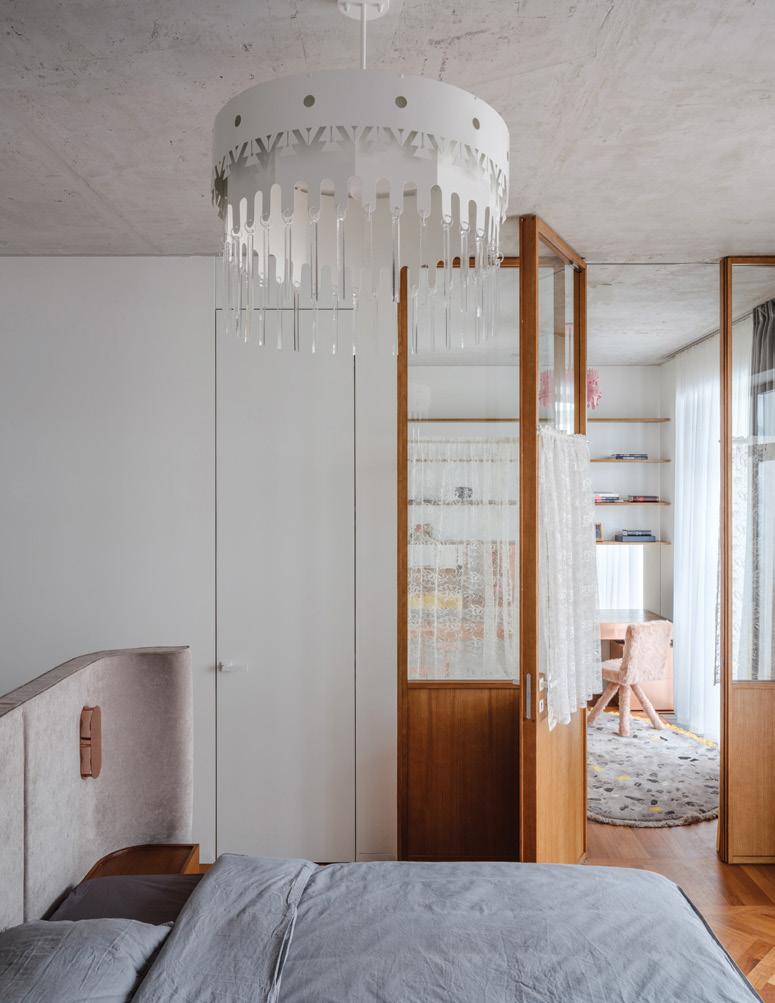
Cruise collection by Ludovica + Roberto Palomba.
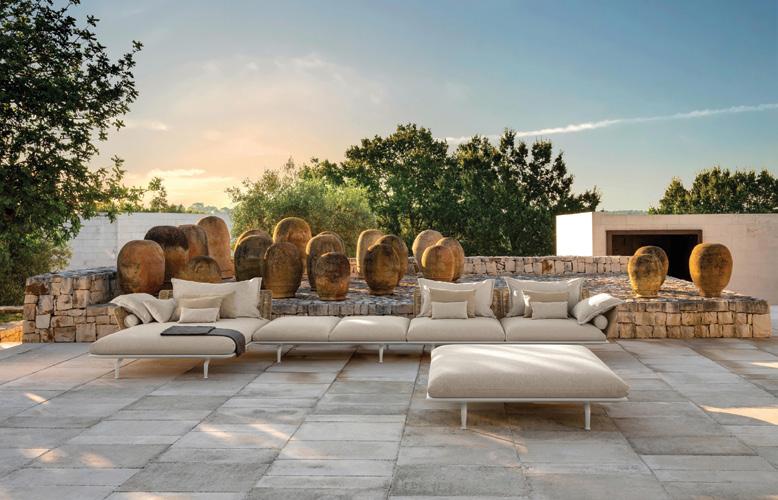
Outdoor living
Umbrian brand Talenti is working with international designers to redefine the outdoor experience
When Talenti made its Salone del Mobile debut in 2009, the Italian brand chose Egyptian-born Canadian industrial designer Karim Rashid to lend his futuristic touch to its first contemporary outdoor collection – a bold move from a firm that had only recently switched its focus from classical garden furniture. It was the first step on the path to bringing Talenti closer to the world of international designers, who have since created many of the Umbrian brand’s outdoor products.
Long before the blurring of indoor and outdoor had become a consumer demand – which has only increased since the start of the COVID-19 pandemic, with many wanting to seek refuge outdoors – Talenti had already begun responding to this shift in modern lifestyles by creating outdoor furniture pieces that are not unlike those found within the interior world, but use durable materials and technologies to allow for a whole new way of living outdoors.
“In an era of forced closures and distancing, the importance of outdoor spaces is set to grow more and more,” says Fabrizio Cameli, Talenti CEO and founder. “People want to rediscover their freedom, including through the virtuous use of the outdoors. From this point of view, design can be a fundamental ingredient in creating outdoor spaces [that are] tailored to individuals, where refined environments are able to reactivate their senses.”
In order to anticipate trends and lifestyle shifts by offering creative and imaginative scenarios for outdoor living, Talenti prioritises its collaborations with designers. The brand has already worked with some of the biggest names in the design world, including Marco Acerbis, Ramón Esteve and Ludovica + Roberto Palomba of Studio Palomba Serafini Associati. Recently, Talenti added the signature of French interior designer Jean-Philippe Nuel to its list of collaborations, with the launch of the Riviera collection in 2020.
“One of Talenti's founding values is a love for creativity, for the forms of beauty realised

by human genius,” says Cameli. “Relying on the imagination and creative power of designers is absolutely fundamental for us. Collaborating with several designers allows us to incorporate different ideas and suggestions from different countries and cultures. All this contributes significantly to the overall creativity of the brand, allowing us to come up with new solutions for people's satisfaction.”
The new Casilda daybed – part of the Casilda collection – has already become something of an icon amongst Talenti’s collections, and was designed by Spanish architect Ramon Esteve, who says, “The daybed stands out for its extraordinary proportions; it is the result of the extreme contrast between mass and lightness. The simplicity of the structure fully highlights the most special elements of the piece, creating an elegant and sophisticated product worthy of the Casilda collection.”
The metal structure of the daybed takes inspiration from a traditional pergola, while its largened soft cushions create an interplay of varying proportions. The geometric lines of its structure additionally highlight the various elements that define the product, such as the straps on the back and the wooden inserts in the armrest.
Talenti’s latest Riviera collection by Nuel comprises sofas, tables, chairs and sun loungers as well as poufs, chairs and coffee tables. With its simultaneous use of ceramics, leather, fabric and aluminium, Riviera is a multi-material collection designed to enrich the outdoors. Its’ sophisticated lines are evident in the two-seater sofa, complete with a waterproof cover, and in the Living armchair that is both wide and deep, making it perfect for relaxation. It is also the first time the brand has used stoneware in its collection, a material which interacts with the other materials in the collection.

Riviera collection by Jean-Philippe Nuel.
Finding balance
At a roundtable held at Cosentino in Dubai, five prominent designers from the Middle East gathered to discuss finding the right balance between current trends in a transitioning world
WORDS BY RAMY AHMED PHOTOGRAPHY BY JOACHIM GUAY
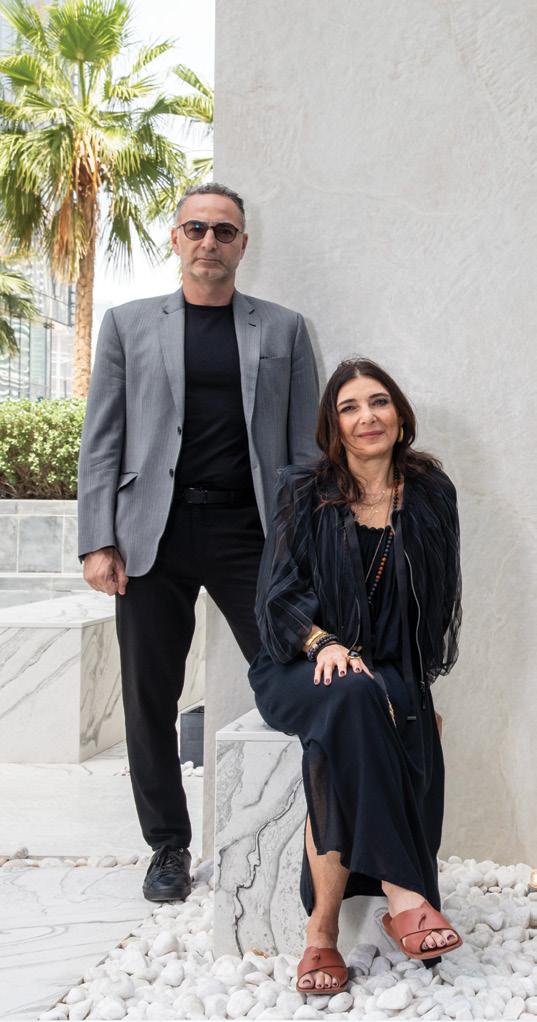
VSHD Design’s Orijins café is a surrealist take on a traditional coffee shop
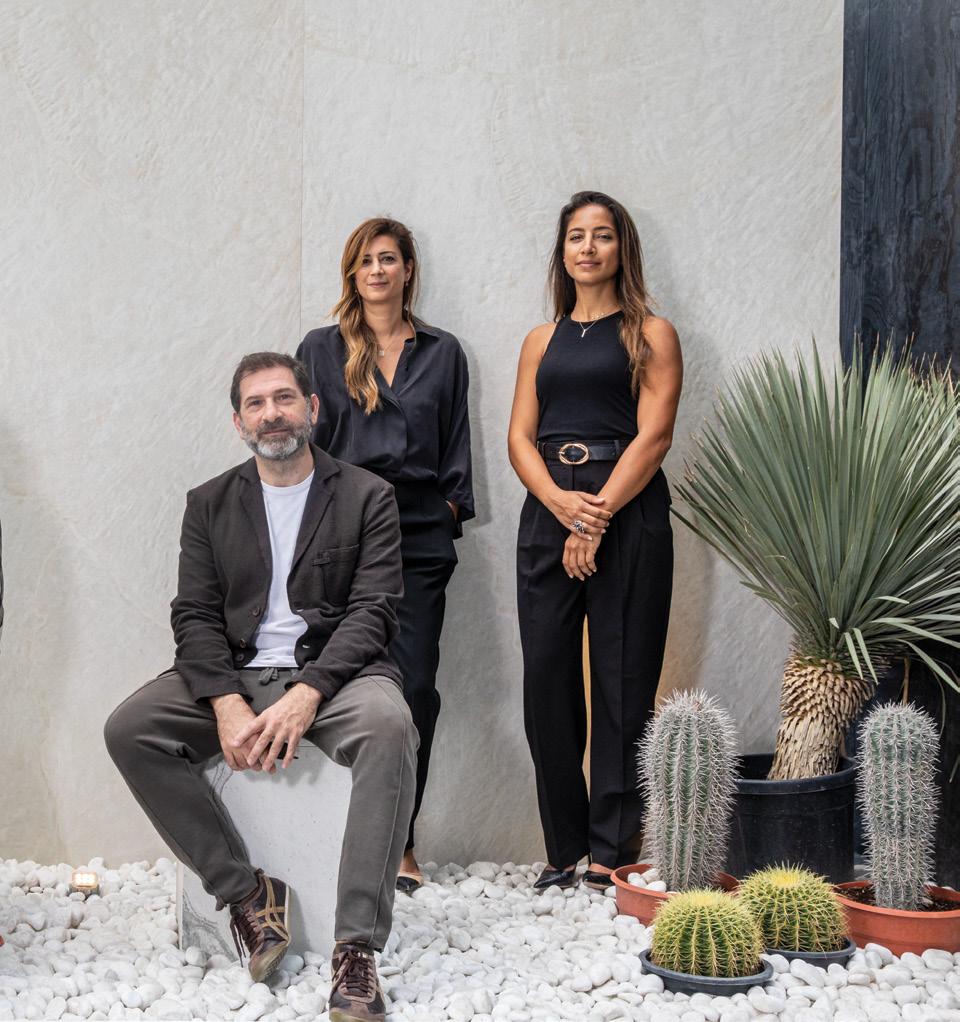

Dana Al Matrook and Newsha Dastaviz, founders of The Line Concept. Emirati designer Aljoud Lootah.

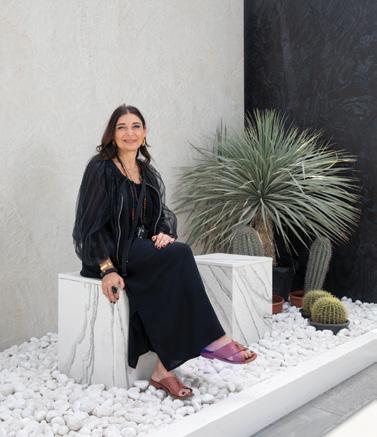
Levantine designer Nada Debs. Mustafa Khamash, founder of Kart Group and Lebanese designer Fadi Sarieddine.

In an effort to foster collaboration and material exploration, surfaces brand Cosentino recently announced the launch of its first capsule collection, a range of furniture and home accessories created with five regional design houses. Using the brand’s Dekton Slim material – a new 4mm ultracompact surface – the bespoke pieces are set to highlight the surface’s functionality and aesthetic value while reflecting the theme of ‘Breaking Boundaries’. The practices and individuals involved in the collection include Studio Nada Debs, Kart Group, Fadi Sarieddine Design Studio, Aljoud Lootah and The Line Concept.
While the collection will launch during Expo 2020 at the Spain Pavilion, and showcased during Downtown Design 2021, the collaboration has kickstarted with a roundtable discussion, during which the designers shared insights into the current state of the furniture design field in the Middle East, and the associated worldwide challenges.
Unsurprisingly, many of the pressing market demands at the moment have been initiated by global responses to the ongoing COVID-19 pandemic. With work-from-home lifestyles becoming increasingly permanent, the need for designs to be shapeshifting in order to accommodate several uses, simultaneously and with ease, has placed practicality and functionality in the spotlight.
“When we’re stuck working at home, new needs start to emerge,” said Fadi Sarieddine, founder of his eponymous design studio. “Your dining table also has to be your desk because we’re not all working with large spaces.”
“It’s about making life simpler,” added Mustafa Khammash, founder of Kart Group. “Multiple areas have become concentrated into one minimal space, so the focus is on function – not [on] the way your surroundings appear.”
For the designers, functionality lends itself to modularity. As professionals balance multiple activities, the need for spaces that flow between purposes has naturally emerged. And with ease of transition comes comfort, as well as positive psychological responses.
“Boundaries between the home and office are very blurred,” said Newsha Dastaviz from contemporary furniture design studio The Line Concept. “And the wellness movement translates to furniture as well. People today buy furniture knowing the power of what we surround ourselves with, and how it impacts our wellbeing.”
The designers agreed that materiality continues to be a priority for consumers, as interactions with objects and spaces (whether physical or visual) are largely dependent on the authenticity of textures and quality; however, now, difficulties in importing goods have reignited conversations around sourcing locally and working with regional artisans – despite the challenges this can pose.
“We have always tried to utilise local materials and work closely with manufacturers based in the UAE as we believe that this will help enhance the creative economy,” said Aljoud Lootah, who contributed to the conversation remotely. “However, during the pandemic and until now, there were specific projects we worked on which required materials that aren’t available in the UAE.”
Although Lootah has managed to source materials from outside her home country, the other designers noted inflated prices and shipping delays as large obstacles to their projects. Another issue raised was that sourcing locally is not always the most costeffective option.
The designers cited additional challenges that have surfaced as a result of the pandemic, such as the recent consumer-led demand to blur indoor and outdoor spaces. And when combined with the need for multi-functional designs, selecting a durable material becomes a game of touch-and-go.
“It’s not easy to have one product with multiple uses in this climate,” said Khammash. “Sometimes, a natural material will not be suitable for different uses, especially in the UAE.”
The challenges in sourcing local materials nearly match those of finding local artisans, who, according to Sarieddine, are gradually vanishing – though both he and Debs strive to nurture traditional craft practises, specifically in their home country of Lebanon, where they’re still very much alive.
“Just caring has become an important thing to do,” said Debs. “We have given too much importance to imported items, and now we’re realising that we have a strong identity. We have the expertise. It can be home-grown, and we should be confident in who we are.”
Regardless of the challenges, the designers agreed on the significance of supporting the local workforce and opting for a minimal approach to manufacturing for environmental reasons. In essence, it’s about doing what you can with what you have.
“We still believe that producing locally will enhance the creative economy,” said Lootah. “Prior to the pandemic, we always worked on incorporating ways to make the projects more sustainable.”
“I think I speak for all of us when I say that all of our items are made to order,” said Dana Al Matrook, co-founder of The Line Concept. “And what does this mean? It means that for every order, we buy the materials needed for that piece, so we aren’t wasting anything and therefore it is a more sustainable solution.”
But beyond what Sarieddine cleverly labelled “design farming”, the designers are seeing a rise in efforts to combine craftsmanship with technology. It’s a balancing act that hasn’t yet been polished, and it’s also been a polarising topic in the past. Many have opted to choose sides rather than find a middle ground. Today, though, things are starting to change, even for designers who prefer to make their pieces by hand.
“3D printing, though it may not be used to produce the actual piece, can make components as simple as nuts and bolts [exactly] the way you want them,” said Matrook. “I would love to see technology [become] more readily available [in order] to recycle organic matter that currently goes to waste. It’s been done before, but it would be great to have that be more accessible.”
“It’s not bad to mix craftsmanship with technology,” said Debs. “That’s the future.” id




